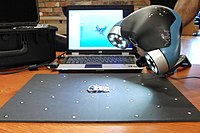
Photo from wikipedia
Background To determine and compare how three-dimensionally accurate scan bodies of different geometric shapes are placed over 6 implants (platform or crestal module). Material and Methods A master plaster model… Click to show full abstract
Background To determine and compare how three-dimensionally accurate scan bodies of different geometric shapes are placed over 6 implants (platform or crestal module). Material and Methods A master plaster model was made with 6 INHEX STD implant analogs made by Mozo-Grau S.A and 4 scan body types were compared. Several groups were made: a control group using a DS101 85G20 contact scanner (Renishaw, Gavá, Spain) and 2 experimental groups using optical scanners: Cerec Omnicam (Sirona, Bensheim, Germany) and Trios 3 (3Shape, Copenhagen, Denmark). 3 parameters were measured on the implants: dis-tance between the axial axes, height difference and angulation difference. Two experienced op-erators scanned 10 times using each of the 2 scanners. The STL files were compared using the “Best-Fit” technique and the data was then extrapolated and processed statistically. Results The scan bodies PRMG (SB3) and TALL (SB4) lead to smaller errors in distance, projected height and angulation than ELOS (SB1) and MG (SB2). Conclusions Despite the results obtained in PRMG (SB3) and TALL (SB4), the scanning errors may still be too large to achieve a good fit in large rehabilitations over implants. Any marginal discrepancy may lead to the failure of the rehabilitation or the implant due to the associated biomechanical problems. Key words:IOS, CAD/CAM, SCAN Bodies.
Journal Title: Journal of Clinical and Experimental Dentistry
Year Published: 2022
Link to full text (if available)
Share on Social Media: Sign Up to like & get
recommendations!